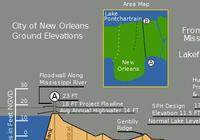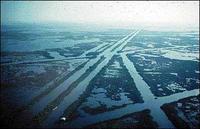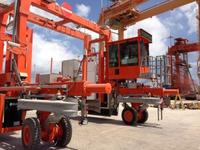-
New levee system offers New Orleans better protection

With the busiest period of the 2013 hurricane season approaching metro New Orleans, the area is ready to face the challenge with a flood control system worth about $14.5 billion. The network of levees, floodwalls, and pumps, its designers say, should nearly eliminate the risk of flooding from most hurricanes, and substantially reduces flooding from hurricanes the size of 2005 Hurricane Katrina.
-
-
Ultrathin radios enable flexible structural-health monitoring system
Currently, engineers can use single-point sensors or fiber optic strips to detect structural problems, but the devices can collect data over relatively small spaces. The problem is that many failures develop over large areas and cannot be detect that at an early stage. The 2007 collapse of a highway bridge in Minneapolis, for example, developed over a gusset plate with an area of several square meters, far too large for current monitoring systems to practically survey. Researchers have developed ultrathin radios which can be embedded directly on plastic sheets, which can be applied to walls and other structures. The innovation could be used for new devices ranging from an invisible communications system inside buildings to sophisticated, flexible structural health monitoring system for use on bridges, buildings, roads, pipelines, and other structures.
-
-
Old concrete helps keep water clean
Lakes and streams are often receiving so much phosphorous that it could pose a threat to the local aquatic environment. Now, researchers show that there is an easy and inexpensive way to prevent phosphorus from being discharged to aquatic environments. The solution is crushed concrete from demolition sites.
-
-
Catastrophes cost global insurance industry more than $20 billion in first half of 2013
Total economic losses from disasters in the first half of 2013 reached $56 billion. Insured losses from natural catastrophes totaled $17 billion, with flooding a main driver. Around 7,000 lives were lost as a result of natural catastrophes and man-made disasters.
-
-
Secure, private Internet and cloud to soldiers, marines at the tactical edge
Squads of soldiers or marines on patrol in remote forward locations often do not have the luxury of quickly sharing current intelligence information and imagery on their mobile devices, because they cannot access a central server. Troops frequently have to wait until they are back at camp to download the latest updates. In the meantime, mission opportunities may erode because the information needed at the tactical edge isn’t immediately available. DARPA’s Content-Based Mobile Edge Networking (CBMEN) program aims to provide an alternative approach to the top down focus of most military networks by starting the content sharing at the individual soldier or marine level.
-
-
Cost of flood losses in major coastal cities to exceed $50 billion by 2050
A new study estimate present and future flood losses — or the global cost of flooding — in 136 of the world’s largest coastal cities, taking into account existing coastal protections. Average global flood losses in 2005, estimated at about $6 billion per year, could increase to $52 billion by 2050 with projected socio-economic change alone. Due to their high wealth and low protection level, three American cities — Miami, New York City, and New Orleans — are responsible for 31 percent of the losses across the 136 cities.
-
-
Accessible critical rare Earth deposit confirmed in Montana
U.S. Rare Earths, Inc. (UREE) the other day announced the results of its 2013 exploration in Lemhi Pass, Montana. The company says the results confirmed that its properties have the highest accessible rare earth deposit in North America.
-
-
Suburban Chicago police cancels anti-terrorism training course after complaints
The police at the city of Lombard, Illinois, has cancelled a class on counterterrorism after the Chicago branch of a Muslim advocacy group complained that the Florida-based instructor and his teachings were blatantly anti-Muslim. The instructor has faced similar criticism in Florida. The course was to be taught through the North East Multi-Regional Training group, which trains Illinois police and corrections employees. The Illinois Law Enforcement Training and Standards Board said it was reviewing the course – titled “Islamic Awareness as a Counter-Terrorist Strategy” – and the materials used in it. The board said that instructor’s qualifications will also be reviewed.
-
-
Sandy shows need for more effective preparedness, resiliency standards
The rebuilding efforts following the devastation wreaked by Superstorm Sandy have triggered a discussion over preparedness and resiliency in America’s commercial and residential buildings.Some experts callfor a presidential appointment of a building resilience “’czar”’ with authority to coordinate and seek synergies between public and private sector initiatives.
-
-
Louisiana energy companies sued over destruction of New Orleans' wetlands

The Louisiana oil and gas industry has dredged more than 10,000 miles of canals through the state’s wetlands, causing the destruction of natural buffers and barriers which, in the past, had moderated the impact of hurricanes and protected New Orleans from severe storms. The Army Corps of Engineers has embarked on a $14.6 billion plan to undo some of the damage caused by the energy companies. The plan consists of levee improvement, wetland restoration, and land reclamation to make New Orleans better protected in the face of rising seas and more frequent and severe extreme weather events. The Southeast Louisiana Flood Protection Authority East (SLFPAE) has filed suit against 94energy companies,asking the court to order the companies to do their part to correct the problem they have caused.
-
-
Heat waves to become more frequent, severe

Climate change is set to trigger more frequent and severe heat waves in the next thirty years regardless of the amount of carbon dioxide (CO2) we emit into the atmosphere, a new study has shown. In the first half of the twenty-first century, these projections will occur regardless of the amount of CO2 emitted into the atmosphere. After then, the rise in frequency of extreme heat waves becomes dependent on the emission scenario adopted.
-
-
Breakthrough fuel cell technology: the future of electricity generation
We currently rely upon an increasingly vulnerable electrical grid to provide the energy we need. The best way to decrease that vulnerability is through distributed energy, that is, by making our own energy on-site. A breakthrough fuel cell technology promises to provide always-on electricity to businesses, homes, and eventually automobiles, at about one-tenth the cost and one-tenth the size of current commercial fuel cell systems. The technology allows people to generate their own electricity with a system nearly impervious to hurricanes, thunderstorms, cyberattacks, derechos, and similar dangers, while simultaneously helping the environment.
-
-
Budding scientists visit leading U.K. science facilities
A group of budding science students visited some of the U.K.’s leading science facilities last week as part of their prize for projects in a national competition. The students all took part in the finals of the U.K. National Science & Engineering Competition at this year’s Big Bang Fair in London. They were judged to be the winner and runners-up for the Institute of Physics (IOP) prize, awarded for the best physics project.
-
-
Detecting radioactive material smuggled in containers

Nearly 90 percent of imported and exported goods travel the globe in shipping containers. Roughly 500 million containers travel the sea each year. A Sandia National Laboratories team completed acceptance testing on an enormous mobile scanner — the Mobile Radiation Detection and Identification System (MRDIS) — which makes smuggling radiological materials in containers more difficult.
-
-
New camouflage makeup shields soldiers, firefighters from heat of bomb blasts, fire
Camouflage face makeup for warfare is undergoing one of the most fundamental changes in thousands of years, as scientists today described a new face paint that both hides soldiers from the enemy and shields their faces from the searing heat of bomb blasts. Firefighters also could benefit from the new heat-resistant makeup.
-
More headlines
The long view
New Technology is Keeping the Skies Safe
DHS S&T Baggage, Cargo, and People Screening (BCP) Program develops state-of-the-art screening solutions to help secure airspace, communities, and borders
Factories First: Winning the Drone War Before It Starts
Wars are won by factories before they are won on the battlefield,Martin C. Feldmann writes, noting that the United States lacks the manufacturing depth for the coming drone age. Rectifying this situation “will take far more than procurement tweaks,” Feldmann writes. “It demands a national-level, wartime-scale industrial mobilization.”
How Artificial General Intelligence Could Affect the Rise and Fall of Nations
Visions for potential AGI futures: A new report from RAND aims to stimulate thinking among policymakers about possible impacts of the development of artificial general intelligence (AGI) on geopolitics and the world order.
Smaller Nuclear Reactors Spark Renewed Interest in a Once-Shunned Energy Source
In the past two years, half the states have taken action to promote nuclear power, from creating nuclear task forces to integrating nuclear into long-term energy plans.
Keeping the Lights on with Nuclear Waste: Radiochemistry Transforms Nuclear Waste into Strategic Materials
How UNLV radiochemistry is pioneering the future of energy in the Southwest by salvaging strategic materials from nuclear dumps –and making it safe.
Model Predicts Long-Term Effects of Nuclear Waste on Underground Disposal Systems
The simulations matched results from an underground lab experiment in Switzerland, suggesting modeling could be used to validate the safety of nuclear disposal sites.
